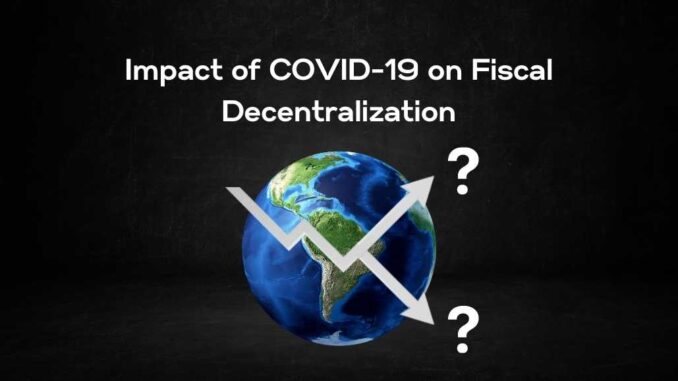
As the severity and scale of the COVID – 19 pandemic became apparent in early 2020, many countries and global actors mobilized to respond to the pressing crisis. In addition to the general demands the pandemic created for strong and competent national and international response, it also raised numerous issues and generated tensions around the sharing of responsibilities and resources among levels of governments in many countries around the world. A number of comparable health and economic issues have emerged fairly universally, but they have manifested in different ways and the responses and results have been diverse across and within countries.
A recent paper from the Inter-American Development Bank (IDB) briefly summarizes available information about how the pandemic has affected fiscal decentralization around the world, but it focuses on five Latin American countries — Argentina, Brazil, Colombia, Mexico, and Peru. It briefly characterizes the intergovernmental fiscal systems in these countries, provides an overview of the known impacts of the pandemic and summarizes available information on government responses to the pandemic, both national and those undertaken by subnational governments with national support or more independently. The conclusions draw some lessons from the country and global experiences and consider if and how post-pandemic policies might be developed to improve the intergovernmental fiscal system in particular countries.
Responding to the Pandemic in the Intergovernmental System
The initial concern in thinking about intergovernmental approaches to the pandemic will naturally center on the immediate response—for example, identifying and treating infected individuals through clinical health services, containing the spread of the virus through epidemiological tracking of transmission for policy and enforcement purposes, and taking steps to mitigate the negative economic and social effects that have materialized or are expected. These are obviously priority measures and merit considerable attention. At the same time, it is also important to recognize that a pandemic can also affect other important services. Many of these public services are commonly provided or shared by subnational governments. There are also interdependencies among local services that merit explicit consideration. For example, reduced access to clean water and sanitation can create health challenges that further strain local clinics at a time when they are already under severe stress or for which people cannot seek treatment because of lockdown policies and/or a lack of transportation to health facilities. Subnational governments are often in a better position to consider the integrated nature of local public services in their own jurisdictions. Such considerations, of course, apply not only to the pandemic, but also to climate change, natural disasters, and other shocks that subnational governments can play a role in addressing.
The need for subnational government public service delivery responses may go well beyond services directly related to infection prevention and treatment; there may be direct implications for local health and well-being and the ability of subnational governments to recover from broader effects of the pandemic. Also potentially relevant is the comparative advantage of local governments (relative to higher levels) in terms of their ability to partner with local nongovernmental organizations (NGOs) and community-based organizations (CBOs) to support pandemic response and delivery of other local services.
The near-term challenge is how to understand details of the evolution of the pandemic impact in particular countries and subnational governments and how essential affected services are for the local economy and citizen well-being. As the immediate demands imposed by the pandemic abate, it will be equally important to consider not only emergency responses to the crisis, but also longer-term implications for sharing of public functions and resources among government levels.
Beyond the public services effects, the pandemic has immediately affected subnational government finances and could impact them for some time to come. Certain expenditures that are less essential (than health) in a pandemic may decline temporarily, but many will likely rise again at a time when local tax bases may be squeezed by the effect of the pandemic on local economies. Services financed by user charges may suffer from lower demand and/or the inability of some consumers of the service to pay. The local public resource constraints imposed by a pandemic may force difficult choices to reprioritize expenditure allocations with little time to perform adequate analysis of the effects of doing so.
A major challenge for many subnational governments around the world is their dependence on central and/or state/regional government resources. Intergovernmental transfers may in some cases initially stagnate or decline as central governments cope with national public finance challenges. In other cases, national governments may make specific efforts to increase resources for subnational governments, as happened in some cases after the 2008 financial crisis. However, these increases are unlikely to be universal or sufficient, especially in poor countries.
Generally, a strong case can be made to increase intergovernmental fiscal transfers to alleviate pandemic effects—although this is difficult when a central government is under considerable fiscal pressure itself. In the immediate crisis mitigation period, the goal could be to help fill revenue gaps that hinder effective subnational government pandemic responses and basic service delivery. The extent to which gaps can be filled, of course, depends on macroeconomic fiscal realities and political economy considerations that vary by country. Beyond determining the volume and allocation of shared resources, decisions are needed regarding the appropriate balance between conditional and unconditional transfers. The instinct in a crisis may be to conditionally target services directly related to crisis response, but this may not be the best approach in all cases.
During a pandemic, additional conditions on resource use may be warranted but, in some situations, it may be productive to grant subnational governments the flexibility to use funds as needed for specific purposes. They—and front-line service deliverers dealing with conditions on the ground—have broader awareness of available resources and immediate needs. Even when certain centrally mandated standardized and coordinated responses are required in a pandemic, the specific managerial path to realizing these responses need not require rigidly programmed conditional transfers. An appropriate balance between unconditional and conditional depends on the context.
The Pandemic as an Opportunity for Broader Intergovernmental Reform
The pandemic offers an opportunity to revisit the role of subnational governments and relationships among levels of government more generally. Official/formal attention to decentralization, intergovernmental relations, and subnational government performance has waxed and waned, even as many countries have typically or increasingly expected more from their subnational governments. Taking advantage of the pandemic to rethink how to enhance subnational government performance in meeting responsibilities—both existing and new—could be a worthwhile endeavor in many countries.
The revenue problem is obviously immediate, but there are also—in conjunction with a possible rethinking of provisions for the intergovernmental sharing of service delivery responsibilities—longer-term implications for ensuring adequate and sustainable subnational revenue systems. Policy responses can focus on improving the framework for subnational own-source revenue generation, user fees and charges, and the level and structure of shared taxes and transfers, as well as adopting measures and improving mechanisms that support subnational borrowing and stronger fiscal responsibility.
Important considerations regarding intergovernmental transfers have long been recognized in the literature. These include how transfer pools are defined, the nature and definition of criteria (based on policy objectives and recipient incentives) used for horizontal allocation of the pool, and as discussed above, the degree of conditionality. There is a growing interest in performance-based transfers that require subnational governments to meet performance targets for the release of funds and for determining the level of funding to be allocated in subsequent years. These are structured in dissimilar ways that create different incentives and various challenges in practice, but they could be a useful element of a post-pandemic intergovernmental fiscal transfer system.
In examining the immediate and possible longer-term changes in fiscal decentralization, the importance of county and within-country context cannot be overemphasized. There have been numerous attempts to promote normatively desirable intergovernmental fiscal reforms that have been hindered by political economy and capacity constraints, among others. Developing a constructive path forward requires documenting the perspectives and priorities of the various actors who must support intergovernmental fiscal reforms, both at specific levels (e.g., between finance ministries and sectoral ministries) and among levels of government. Understanding the nature and extent of relevant common views and tensions is essential to make judgments about which types of reforms are feasible in the management of the COVID-19 pandemic and beyond.
Some of the issues that have been evident during the COVID-19 pandemic are similar to concerns that have long been debated in the development and development assistance literature (both general and decentralization-specific), particularly around the perceived tradeoff between emergency response/humanitarian assistance and building government systems and capacity. For many years these were seen as separate concerns—conventional wisdom was to deal with an immediate predicament, even if it meant setting up parallel mechanisms—and only later worry about strengthening local institutions.
Eventually, emergency response activities came to be seen as an opportunity both to deal with crisis and to develop and institutionalize public sector capacity and improve performance. Such an approach during a pandemic—to the extent it is feasible in a particular case—may both contribute to improved institutional structures and routine operations and leave countries and subnational governments in a better position to prepare for and deal with future pandemics and other natural emergencies, as well as to better manage their finances in general.
Paper Overview
The paper is organized as follows:
- Section 1 – summarizes how the pandemic has affected fiscal decentralization around the world. The literature is uneven and there is still only limited formal research, with much of the work to date more descriptive and impressionistic. Nevertheless, some common impacts, responses, concerns, and lessons are identified.
- Section 2 – briefly compares the intergovernmental systems in the five countries under consideration here—Argentina, Brazil, Colombia, Mexico, and Peru. These reviews are not comprehensive but set the stage for the discussion of pandemic impacts and response.
- Section 3 – provides an overview of the known impacts the pandemic on the five countries. There is a brief summary of broader national impacts, but the focus is on what is known about the impacts on subnational governments, particularly regarding fiscal matters and service provision.
- Section 4 – reviews available information on government responses to the pandemic. There is a brief review of all national responses, but the focus is on national support to subnational governments and selective coverage of subnational responses.
- Section 5 – synthesizes the main experiences and draws some lessons from the country and global experiences about if and how post-pandemic policies might be developed to improve the intergovernmental fiscal system in specific countries.
Smoke, P., Gómez-Álvarez, D., Muñoz Miranda, A., & Radics, A. (2022). The role of subnational governments in the COVID-19 pandemic response: Are there opportunities for intergovernmental fiscal reform in the post-pandemic world? https://doi.org/10.18235/0004391.
Read the full paper on IDB’s website here.



